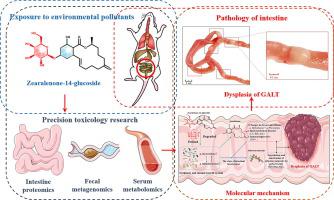Journal of Advanced Research ( IF 10.7 ) Pub Date : 2023-05-23 , DOI: 10.1016/j.jare.2023.05.006 Haonan Ruan 1 , Yunyun Wang 1 , Jing Zhang 1 , Ying Huang 1 , Yanan Yang 1 , Chongming Wu 1 , Mengyue Guo 1 , Jiaoyang Luo 1 , Meihua Yang 1

|
Introduction
Zearalenone-14-glucoside (Z14G) is a modified mycotoxin that widely contaminates food across the world. Our preliminary experiment showed that Z14G degrades to zearalenone (ZEN) in the intestine exerting toxicity. Notably, oral administration of Z14G in rats induces intestinal nodular lymphatic hyperplasia.
Objectives
To investigate the mechanism of Z14G intestinal toxicity and how it differs from ZEN toxicity. We conducted a precise toxicology study on the intestine of rats exposed to Z14G and ZEN using multi-omics technology.
Methods
Rats were exposed to ZEN (5 mg/kg), Z14G-L (5 mg/kg), Z14G-H (10 mg/kg), and pseudo germ free (PGF)-Z14G-H (10 mg/kg) for 14 days. Histopathological studies were performed on intestines from each group and compared. Metagenomic, metabolomic, and proteomic analyses were performed on rat feces, serum, and intestines, respectively.
Results
Histopathological studies showed that Z14G exposure resulted in dysplasia of gut-associated lymphoid tissue (GALT) compared to ZEN exposure. The elimination of gut microbes in the PGF-Z14G-H group alleviated or eliminated Z14G-induced intestinal toxicity and GALT dysplasia. Metagenomic analysis revealed that Z14G exposure significantly promoted the proliferation of Bifidobacterium and Bacteroides compared to ZEN. Metabolomic analysis showed that Z14G exposure significantly reduced bile acid, while proteomic analysis found that Z14G exposure significantly reduced the expression of C-type lectins compared to ZEN.
Conclusions
Our experimental results and previous research suggest that Z14G is hydrolyzed to ZEN by Bifidobacterium and Bacteroides promoting their co-trophic proliferation. This leads to inactivation of lectins by hyperproliferative Bacteroides when ZEN caused intestinal involvement, resulting in abnormal lymphocyte homing and ultimately GALT dysplasia. It is noteworthy that Z14G is a promising model drug to establish rat models of intestinal nodular lymphatic hyperplasia (INLH), which is of great significance for studying the pathogenesis, drug screening and clinical application of INLH.
中文翻译:

玉米赤霉烯酮-14-葡萄糖苷特异性促进肠道相关淋巴组织发育不良:构建肠结节性淋巴增生模型的天然产物
介绍
玉米赤霉烯酮-14-葡萄糖苷 (Z14G) 是一种改良的霉菌毒素,广泛污染世界各地的食品。我们的初步实验表明,Z14G 在肠道中降解为玉米赤霉烯酮 (ZEN),产生毒性。值得注意的是,大鼠口服 Z14G 会诱导肠道结节性淋巴增生。
目标
研究 Z14G 肠道毒性的机制及其与 ZEN 毒性的区别。我们利用多组学技术对暴露于 Z14G 和 ZEN 的大鼠肠道进行了精确的毒理学研究。
方法
将大鼠暴露于 ZEN (5 mg/kg)、Z14G-L (5 mg/kg)、Z14G-H (10 mg/kg) 和假无菌 (PGF)-Z14G-H (10 mg/kg) 中14天。对每组的肠道进行组织病理学研究并进行比较。分别对大鼠粪便、血清和肠道进行宏基因组学、代谢组学和蛋白质组学分析。
结果
组织病理学研究表明,与 ZEN 暴露相比,Z14G 暴露会导致肠道相关淋巴组织 (GALT) 发育不良。PGF-Z14G-H组中肠道微生物的消除减轻或消除了Z14G诱导的肠道毒性和GALT发育不良。宏基因组分析显示,与 ZEN 相比, Z14G 暴露显着促进双歧杆菌和拟杆菌的增殖。代谢组学分析表明,Z14G 暴露显着降低了胆汁酸,而蛋白质组学分析发现,与 ZEN 相比,Z14G 暴露显着降低了 C 型凝集素的表达。
结论
我们的实验结果和之前的研究表明,Z14G 被双歧杆菌和拟杆菌水解为 ZEN ,促进其共养增殖。当 ZEN 引起肠道受累时,这会导致过度增殖的拟杆菌使凝集素失活,导致淋巴细胞归巢异常,最终导致 GALT 发育不良。值得注意的是,Z14G是建立肠结节性淋巴增生(INLH)大鼠模型的一种很有前景的模型药物,对于研究INLH的发病机制、药物筛选和临床应用具有重要意义。


























 京公网安备 11010802027423号
京公网安备 11010802027423号